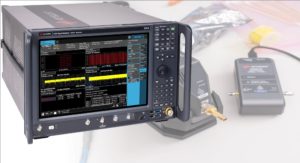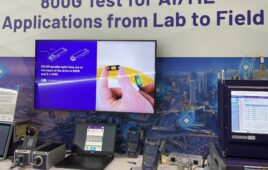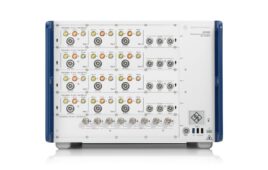Keysight’s N9042B UXA X-Series signal analyzer lets you analyze mmWave and sub-6 GHz signals while keeping the noise down.
 5G mmWave carrier frequencies bring wider channel bandwidth and higher data rates than ever before. With those higher frequencies and their wider bandwidths come propagation and noise problems not present at lower frequencies. Engineers who test signal quality in modems, amplifiers, passive components, subsystems, and systems need equipment that keeps up with the signals and noise. Keysight’s N9042B UXA X-Series signal analyzer widens measurement analysis bandwidth and lowers noise compared to previous models.
5G mmWave carrier frequencies bring wider channel bandwidth and higher data rates than ever before. With those higher frequencies and their wider bandwidths come propagation and noise problems not present at lower frequencies. Engineers who test signal quality in modems, amplifiers, passive components, subsystems, and systems need equipment that keeps up with the signals and noise. Keysight’s N9042B UXA X-Series signal analyzer widens measurement analysis bandwidth and lowers noise compared to previous models.
The UXA X-Series consists of three frequency options: 2 Hz to 26.5 GHz, 44 GHz, and 50 GHz. That covers today’s 5G mmWave frequencies. Adding the V3050A signal analyzer frequency extender lets you measure at frequencies to 110 GHz for military communications and radar signal analysis.
5G mmWave signals expand bandwidth to 2 GHz. To analyze that width, the N9042B can analyze signals to 4 GHz with Option R40. Other analysis bandwidth options: 1 GHz (option R10), 1.5 GHz (option R15), and 2 GHz (option R20) at 12 bits. With an external digitizer, the N9042B can achieve approximately 11 GHz of analysis bandwidth at 10 bits.
As channel bandwidths widen, they bring with them more noise. Test equipment also adds noise to measurements. To compensate, the N9042B lowers the internal noise compared to previous models. The plot below shows a displayed average noise level (DANL) reduction from 4 dB to 8 dB depending on frequency.
 Because 5G New Radio uses complex modulation, you need software to perform the actual signal analysis. Keysight’s Pathwave X-Series measurement applications extend signal-analysis options to the N9042B. A total of 54 software modules add to the analyzer’s capabilities, four of which serve 5G measurements. In particular, the 5G NR (New Radio) Measurement Application provides measurements that include:
Because 5G New Radio uses complex modulation, you need software to perform the actual signal analysis. Keysight’s Pathwave X-Series measurement applications extend signal-analysis options to the N9042B. A total of 54 software modules add to the analyzer’s capabilities, four of which serve 5G measurements. In particular, the 5G NR (New Radio) Measurement Application provides measurements that include:
- Downlink and uplink measurement for 3GPP Releases 15 and 16, including Release 16 defined eDSS (Enhanced Dynamic Spectrum Sharing) and eMIMO (Enhanced MIMO)
- Downlink modulation analysis for synchronization signal block (PSS+SSS+PBCH) PBCH-DMRS, PDSCH, PDSCH-DMRS, PDSCH-PTRS, PDCCH, PDCCH-DMRS, CSI-RS and decoding for PBCH, PDCCH, and PDSCH
- Uplink modulation analysis for SRS, PUSCH, PUSCH-DMRS, PUSCH-PTRS, PUCCH, PUCCH-DMRS, and PRACH and decoding for PUCCH and PUSCH
- Spectrum and power measurements such as channel power, spectral emissions mask (SEM), adjacent channel power (ACP), occupied bandwidth (OBW), spurious emissions, transmit On/Off power and Complementary Cumulative Distribution Function (CCDF).
- Modulation analysis measurements such as I/Q measured constellation, EVM (rms, peak), frequency error, symbol clock error, I/Q offset, rrror vector time, Error vector spectrum, In-band emission, Power vs. slot/symbol, EVM vs. RB, time alignment error (TAE) and frame summary.
 Other analysis functions are available through Keysight’s PathWave Vector Signal Analysis (89600 VSA) software.
Other analysis functions are available through Keysight’s PathWave Vector Signal Analysis (89600 VSA) software.
Whenever you make high-frequency measurements, you must calibrate your test setup to compensate for losses in cables, connectors, and other components. To deal with these losses at such high frequencies, you need a known signal. Keysight has added a new calibrator, the U9361 RCal receiver calibrator, to its list of accessories. Controlled and powered through a USB port, the calibrator is available in models that produce signals on known amplitude and frequency up to 110 GHz.




Tell Us What You Think!